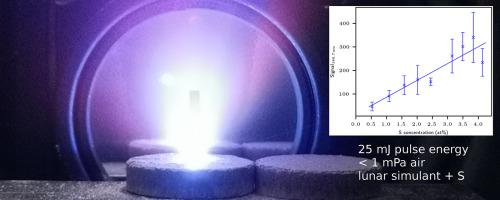当前位置:
X-MOL 学术
›
Spectrochim. Acta B. At. Spectrosc.
›
论文详情
Our official English website, www.x-mol.net, welcomes your feedback! (Note: you will need to create a separate account there.)
Detecting sulfur on the Moon: The potential of VUV-LIBS
Spectrochimica Acta Part B: Atomic Spectroscopy ( IF 3.3 ) Pub Date : 2020-12-01 , DOI: 10.1016/j.sab.2020.105990 Simon Kubitza , Susanne Schröder , Enrico Dietz , Sven Frohmann , Peder Bagge Hansen , Kristin Rammelkamp , David Sebastian Vogt , Michael Gensch , Heinz-Wilhelm Hübers
Spectrochimica Acta Part B: Atomic Spectroscopy ( IF 3.3 ) Pub Date : 2020-12-01 , DOI: 10.1016/j.sab.2020.105990 Simon Kubitza , Susanne Schröder , Enrico Dietz , Sven Frohmann , Peder Bagge Hansen , Kristin Rammelkamp , David Sebastian Vogt , Michael Gensch , Heinz-Wilhelm Hübers

|
Abstract Laser-induced breakdown spectroscopy (LIBS) receives increasing interest in the field of space exploration. Some volatile elements important to planetary research are, however, challenging to detect with conventional LIBS because their strongest emission lines lie in the vacuum-UV (VUV) spectral range below 200 nm. We demonstrate the potential of LIBS detection in the VUV range from 125 to 190 nm on one of the relevant challenging elements, S, in a lunar context. With our laboratory set-up, we detected S in lunar analogues at concentrations ranging from 0.5 to 4.0 at% in a time-integrated configuration. The experiments were conducted in high vacuum (10−3 Pa) with laser parameters realistic for a space instrument (1064 nm, 25 mJ, 6 ns). The results indicate improved detection capabilities for S in a lunar geological context as compared to LIBS in the more common UV/VIS/NIR spectral range. We found limits of detection in the order of 0.5 at% S for all investigated sample series. Normalization by total intensity and by an internal standard, in our case by the emission signal of the O I triplet at 130 nm, was tested as well, but did not yield a noticeable improvement for our data. Besides S, we were also able to detect Al, Fe, O, Si and Ti from the lunar analogue matrix.
中文翻译:

探测月球上的硫:VUV-LIBS 的潜力
摘要 激光诱导击穿光谱(LIBS)在太空探索领域越来越受到关注。然而,一些对行星研究很重要的挥发性元素很难用传统的 LIBS 检测到,因为它们最强的发射线位于 200 nm 以下的真空紫外 (VUV) 光谱范围内。我们展示了在月球环境中相关挑战性元素之一 S 上 125 至 190 nm VUV 范围内 LIBS 检测的潜力。通过我们的实验室设置,我们在时间积分配置中检测到月球类似物中 S 的浓度范围为 0.5 到 4.0 at%。实验在高真空 (10-3 Pa) 中进行,激光参数对于空间仪器 (1064 nm, 25 mJ, 6 ns) 是现实的。结果表明,与更常见的 UV/VIS/NIR 光谱范围内的 LIBS 相比,月球地质环境中 S 的检测能力有所提高。我们发现所有研究的样品系列的检测限都在 0.5 at% S 的数量级。通过总强度和内标(在我们的例子中通过 130 nm 的 OI 三联体的发射信号)的标准化也进行了测试,但对我们的数据没有产生明显的改善。除了 S,我们还能够从月球模拟矩阵中检测到 Al、Fe、O、Si 和 Ti。但对我们的数据并没有产生明显的改善。除了 S,我们还能够从月球模拟矩阵中检测到 Al、Fe、O、Si 和 Ti。但对我们的数据并没有产生明显的改善。除了 S,我们还能够从月球模拟矩阵中检测到 Al、Fe、O、Si 和 Ti。
更新日期:2020-12-01
中文翻译:

探测月球上的硫:VUV-LIBS 的潜力
摘要 激光诱导击穿光谱(LIBS)在太空探索领域越来越受到关注。然而,一些对行星研究很重要的挥发性元素很难用传统的 LIBS 检测到,因为它们最强的发射线位于 200 nm 以下的真空紫外 (VUV) 光谱范围内。我们展示了在月球环境中相关挑战性元素之一 S 上 125 至 190 nm VUV 范围内 LIBS 检测的潜力。通过我们的实验室设置,我们在时间积分配置中检测到月球类似物中 S 的浓度范围为 0.5 到 4.0 at%。实验在高真空 (10-3 Pa) 中进行,激光参数对于空间仪器 (1064 nm, 25 mJ, 6 ns) 是现实的。结果表明,与更常见的 UV/VIS/NIR 光谱范围内的 LIBS 相比,月球地质环境中 S 的检测能力有所提高。我们发现所有研究的样品系列的检测限都在 0.5 at% S 的数量级。通过总强度和内标(在我们的例子中通过 130 nm 的 OI 三联体的发射信号)的标准化也进行了测试,但对我们的数据没有产生明显的改善。除了 S,我们还能够从月球模拟矩阵中检测到 Al、Fe、O、Si 和 Ti。但对我们的数据并没有产生明显的改善。除了 S,我们还能够从月球模拟矩阵中检测到 Al、Fe、O、Si 和 Ti。但对我们的数据并没有产生明显的改善。除了 S,我们还能够从月球模拟矩阵中检测到 Al、Fe、O、Si 和 Ti。



























 京公网安备 11010802027423号
京公网安备 11010802027423号